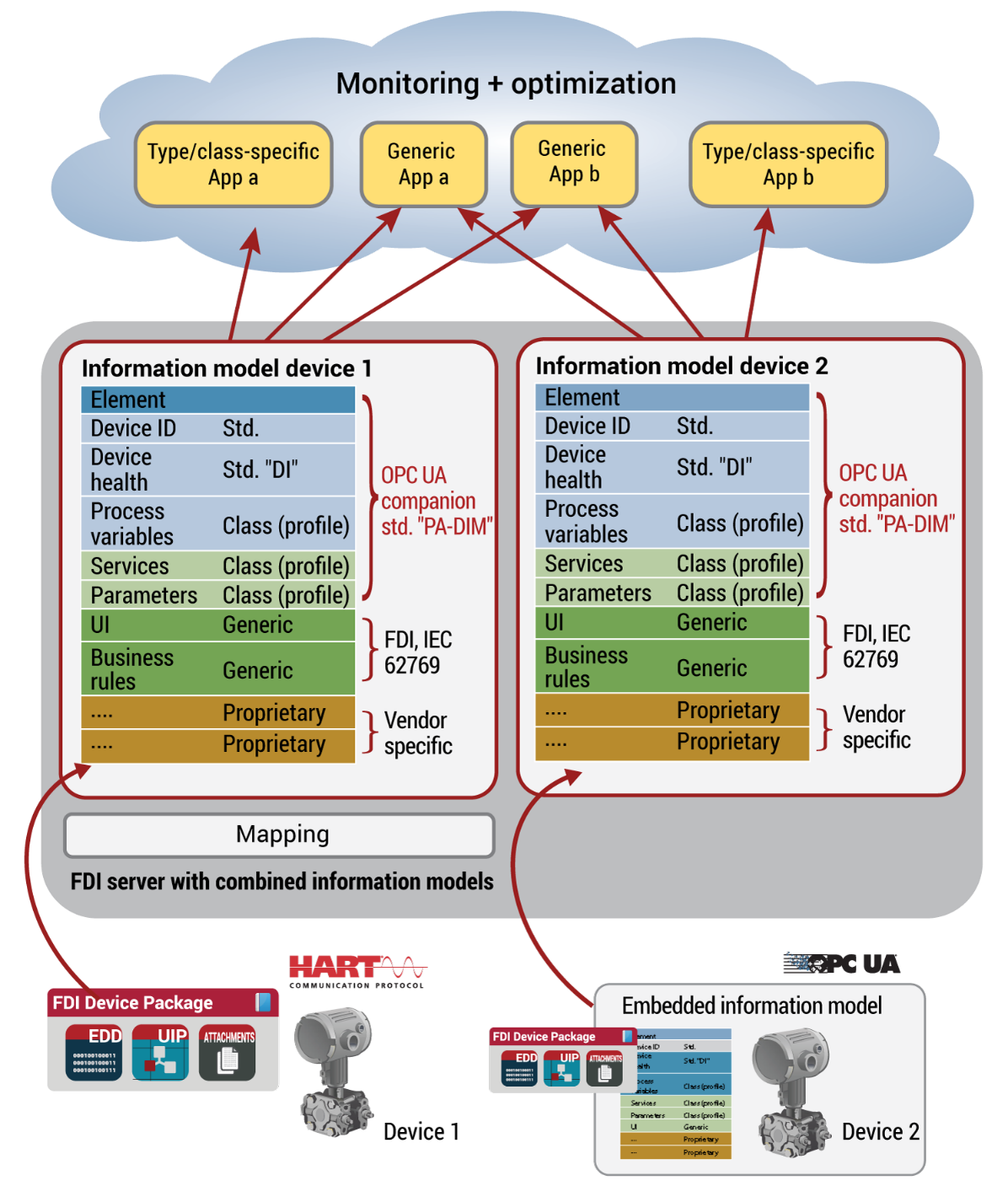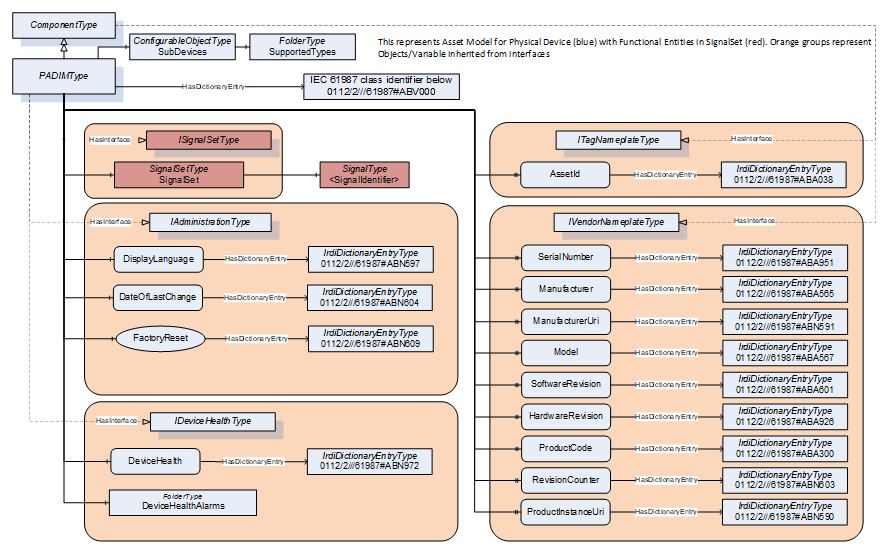Purpose
The PA-DIM activities started in 2017 as a Joint Working Group of the OPC Foundation (OPC) and the FieldComm Group, Inc. (FCG). In 2022 the ownership has been extended – the complete list of co-owners is now : FDT Group, FieldComm Group, ISA 100 WCI, NAMUR, ODVA, OPC Foundation, PROFIBUS and PROFINET International, VDMA, and ZVEI.
PA-DIM defines the OPC UA Information Model to represent and access Process Automation Devices.
Scope
- The scope of the Joint Working Group is to Prepare and propose enhancements to the OPCUA Unified Architecture for Devices (DI) companion specification
- Ensure compatibility between FDI Technology specifications and the OPCUA Unified Architecture for Devices (DI) companion specification
- Specify and maintain OPC UA Information Models for Process Automation Devices initially based on NAMUR Core Parameters according to NE 131 including assignment of semantic identifiers according the IEC Common Data dictionary and/or eCl@ss
- Enhance the OPC UA Information Model for FDI based on requirements from e.g. NAMUR Open Architecture, Industrie 4.0 or IIoT initiatives
FDI Technology and the OPC UA Information Model for Process Automation Device shall enable client applications to access device information and specifically Process Automation Device Information in a standardized vendor independent way and independent of specific fieldbus protocols. The access can happen through an OPC UA Server directly integrated in a Process Automation Device, or through an OPCUA Server aggregating multiple Object Dictionaries of multiple Process Automation Devices, or through the Object Dictionary of an FDI OPC UA Server representing multiple Process Automation Devices. By this device information can be provided to the enterprise level, e.g. for diagnostics, configuration, condition monitoring, visualization, maintenance etc.
Technical overview
Use cases
The use cases covered in this version are listed in Table 8. These use cases can be broken into Telemetric and Asset Management categories. Telemetric use cases publish dynamic data e.g. to a cloud application for remote monitoring. Asset Management use cases require client server interaction with the information model typically for on-premises applications.
 Table 1 – Device Information Model Use Cases
Table 1 – Device Information Model Use Cases
Use cases define the content of this Device Information Model. NAMUR Open Architecture (NE175) defines uses cases with parameters, names and semantic ids, which are an important input for the definition of the PA-DIM. Additional details about these uses cases can be found in the NAMUR descriptions found on their web site referenced in Section 2. In future revisions of this specification further parameters can be added to fulfil additional requirements or to cover additional use cases
The Joint specification describes a unified Process Automation Device Information Model (PA-DIM) that enables protocol and vendor independent data exchange. Figure 1 provides an example illustration of a system in which two Devices interact with several applications running in the cloud and accessing generic and product type data. The Information Model of these two devices includes a standardized device model based on PA-DIM. The model also exposes IEC 61987 semantic dictionary IDs. These IDs may be used by OPC UA clients to obtain the definition of vendor specific data the devices may contain
 Figure 1 – Protocol Independent Information Model
Figure 1 – Protocol Independent Information Model
PA-DIM makes use of the Dictionary Reference model defined in OPC 10000-19 and defines the proper International Registration Data Identifiers (IRDI) for entries in the IEC 61987 CDD. The OPC Foundation added a new abstract DictionaryEntryType ObjectType to the OPC 10000-5 specification. It also introduced the new IrdiDictionaryEntryType ObjectType for semantic information and the HasDictionaryEntry ReferenceType to associate it to any node.
The PA-DIM, illustrated in Figure 2, defines a base device concept and information model, which is intended to be used for Process Automation Devices. This PA-DIM OPC UA Companion Specification defines the OPC UA BrowseNames and corresponding IEC 61987 Semantic CDD Dictionary IDs. For each Node with a dictionary reference to the IEC Common Data Dictionary, the definition of the referenced CDD entry applies. It is expected, that eCl@ss semantic description will follow the IEC 61987 standardization where applicable.
The PADIMType has a HasDictionaryEntry reference to an IRDI representing a class identifier within the IEC 61987 CDD (e.g. Coriolis Flowmeter, Pressure Transmitter, etc.).
The DisplayName Attribute for all Objects, Variables, and Methods with a DictionaryReference in this specification shall be according to IEC 61987 CDD PROPERTY attribute “Short name” or to IEC 61987 CDD CLASS attribute “Preferred name”. DisplayNames are used for configuration dialog displays and are defined within the IEC CDD 61987 CDD according NAMUR NE131 / NOA device parameter names.
PA-DIM defines the Interfaces IAdministrationType for administration purposes and ISignalSetType as a container for process variables (see 7.1). The PADIMType includes these Interfaces, and additionally it includes the IDeviceHealthType, provided by OPC 10000-100. Furthermore PADIMType provides a reference to an IRDI dictionary entry to reference the device class (e.g. Pressure Transmitter or Coriolis Mass Flowmeter) and SubDevices Object for modular devices.
Instances of PADIMType represent devices in the real-world. There might be other OPC UA companion specifications representing different aspects of the same real-world device, potentially represented in the same OPC UA Server. Therefore, the guidelines defined in the OPC UA for Devices specification (OPC 10000-100 Annex C) should be followed, when an OPC UA server represents several companion specifications for the same real-world device.
Information
- Downloads
- Specification PA-DIM: Click here
- Brochure PA-DIM: Click here
- Video by Chairperson Frank Fengler about PA-DIM: Click here
.
- Contact
Chairperson Frank Fengler frank.fengler_at_de.abb.com




